| Phelsuma
astriata astriata Endemic
|
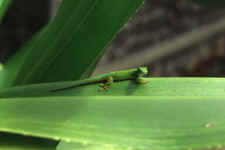
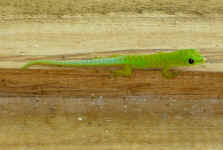
A P.a.astriata juvenile visiting
the laboratory from NPTS
|
One
of the smaller species in the Phelsuma family, with a total length of 13 cm. The
habitat from these jewels are the lower coastal regions. The
best place to observe these animals are the small coconut trees in the hotel.
Especially in the morning when they sunbath on the unripe nuts, licking the
nectar from the small flowers of these trees. They lay two eggs between the
coconut tree leaves every 4 to 6 weeks. the incubation time is 2 to 3 months
depending from the temperature. The difference with P. s. longinsulae
is, that P. a. astriata has a bluish tail, especially the males, and has
greener, less spotted legs. |
|
|
|
|
|
| Phelsuma
sundbergi longinsulae Endemic
|
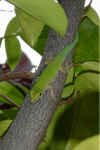 
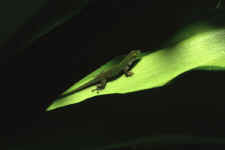
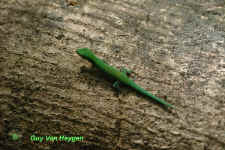
|
These
animals prefer rougher surfaces, so they are easier to find on the takamaka
trees in front of the bungalows in the hotel. Their total length is 16 cm. The
reproduction is the same as from P. astriata astriata, but the eggs are laid
behind the loose bark of the takamaka trees, protected from the sun and the
rain. A lot of eggs are lost, by sticking in the resin from the tree. (see
picture bellow). |
| ____________________________________ |
|
|
|
| Night
geckos
|
| Gehyra
mutilata |
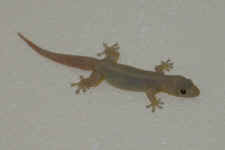
|
Probably the most common gecko on earth. At sundown they appear from their
hiding places, and post around the lights, waiting for their dinner, which
consist of insects attracted by the light.
|
|
|
| Hemidactylus
frenatus |
|
|
|
Ailuronyx
Sloughing
skin geckos
|
| A
genus only occurring on the granite islands of the Seychelles. They owe their
English name to the fact that, if a predator catches them, they throw off their skin, and try
to escape . They live on trees and banana bunches, but can also be
found in houses. Their diet consists of insects and fruit.
|
| Ailuronyx
seychellensis
Bronze gecko Endemic |
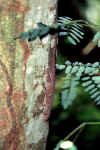 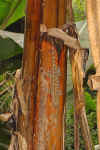 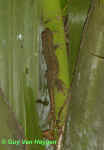 |
The
largest of the three species, reaching 25 cm,
|
| Ailuronyx
tachyscopaeus Endemic
|
| Stays
smaller 20 cm
|
|
| Ailuronyx
trachygaster
Endemic
|
| The
smallest with maximum 15 cm.
|
|
| Skinks
|
|
| Mabuya
seychellensis Endemic
|
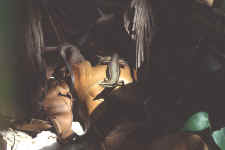 |
This
is a very common skink you can find all over the island.
|
| Pamelaescincus
gardineri Endemic
|
| A
smaller skink than Mabuya seychellensis, difficult to find, and living in the
higher regions.
|
| Snakes
|
|
| Contrary
to what the local people pretend there are no dangerous or venomous snakes on
the Seychelles, thus not on Silhouette. The only snakes occurring on Silhouette
are: |
| Lamprophis
geometricus (Seychelles house
snake) |
| |
A very rare and
difficult to find snake. |
| Lycognatophis
seychellensis (Seychelles wolf
snake) Endemic, before
Scopelophis
seychellensis. |
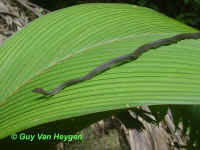
Scopelophis
seychellensis.
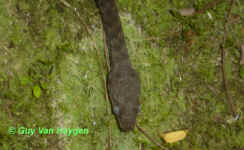
Scopelophis
seychellensis.
|
This
harmless snake can reach more than 1 meter. It is wide spread and can be found from the
coast till high in the mountains. The colour varies from brown to black, and the
ventral side is always white. Their
diet is varied: young birds, lizards, frogs and insects, and the last 200 years mice
and young rats.
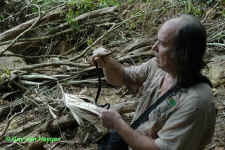
Scopelophis
seychellensis.
|
|
Chameleons
|
|
|
Only
one specie of chameleon occurs on Silhouette and the rest of the Seychelles.
Like the phelsumas they originate from Madagascar. |
|
Calumma
tigris
Endemic |
|
|
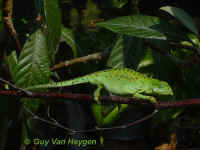
A typical green female Calumma
tigris
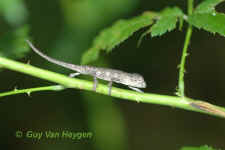
A 10 minutes old hatchling Calumma
tigris


2 young males Calumma
tigris
|
The
tiger chameleon is endemic to the Seychelles and occurs only on the islands
Mahe, Praslin and Silhouette, and not on the islands Niol and Misère like it
is wrongly mentioned in some literature. Le Niol and La Misère are regions on Mahe
where indeed the tiger chameleon can be found. It is a very rare and shy animal,
on Silhouette only found higher than 200 meters. His colour varies from yellow
over green to dark brown, mostly with black spots. On Silhouette C. tigris is
greener than on the other islands. With his 16cm length, he
belongs to the smaller chameleons.
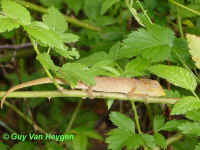
A juvenile Calumma
tigris
|
|
|
|
| Terrapins
or fresh water turtles.
|
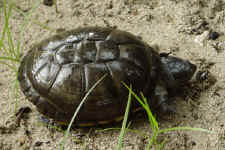
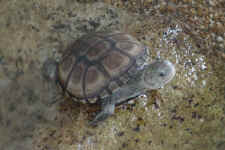
An adult
(up) and a 6 month old juvenile (under) Pelusios
subniger parietalis.
|
On
the Seychelles occur 2 species of terrapins, both represented by endemic
subspecies; Pelusios castanoides intergularis or yellow bellied mud
turtle and the black mud turtle Pelusios subniger parietalis. About a
third taxon is some uncertainty whether it concerns Pelusios seychellensis, an
endemic specie, or a variant of Pelusios castanoides. Of these species Pelusios
seychellensis seems to be extinct (at least as a pure bred form). Pelusios
castanoides intergularis and Pelusios subniger parietalis live in
marches on Mahe, Praslin, Silhouette, La Digue and Fregate. Many of these
marshes are drained. A real catastrophy was the drainage of the marsh at
Anse Kerlan
on
Praslin to allow
the development from the Lemuria golf course. None of the nature protection
organisation were informed, so the populations of P. castanoides and P.
subniger were reduced to respectively 180 and 150 or with 57 and 21%. Both are critically
endangered.
These two species have been the subject of a captive breeding project by
Nature Protection Trust of Seychelles since 1997. |
|
Giant
Tortoises |
|
|
|
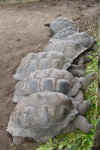 Clio
Phoenix
Josphine
Stan
Adam
Chiron Christopher
being fed Clio
Phoenix
Josphine
Stan
Adam
Chiron Christopher
being fed
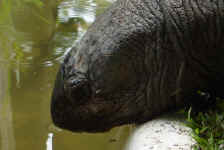
All Indian Ocean tortoises drink through
their nose
|
In recent times the genus Dipsochelys inhabited most of the
western Indian Ocean islands. Exploitation by humans led to the
extinction of all wild populations by 1840, with the exception of the
Aldabra group Dipsochelys dussumieri (previously Geochelone
gigantea or Dipsochelys elephantina) In total there were 6
species of Dipsochelys, three inhabited the granite group of
the Seychelles islands, one Aldabra and the two others Madagascar.
|
| |
|
Seychelles: D. hololissa; D. arnoldi andthe
extinct D.
daudinii
Aldabra:
D. dussumieri
Madagascar: D. abrupta and
D. grandidieri both
extinct.
Actually there are 8 specimens known living in captivity in Seychelles
from D. hololissa,
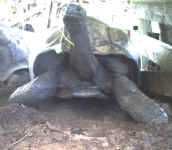
Adam (285kg) together with his first
baby Gery (0,041kg).
and 18 D.
arnoldi.
In 1997 Nature Protection Trust of Seychelles started a breeding
project on Silhouette for these 2 species.
